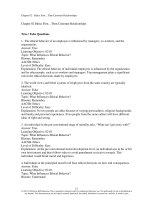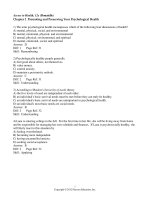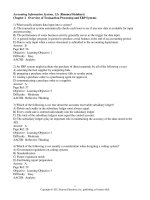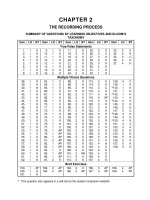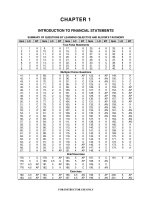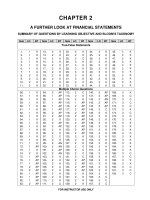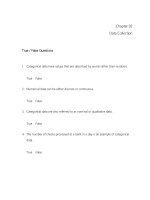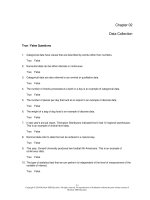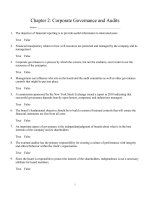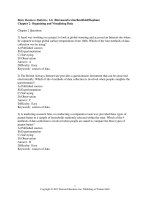Business communication today 12th edition bovee test bank
Bạn đang xem bản rút gọn của tài liệu. Xem và tải ngay bản đầy đủ của tài liệu tại đây (249.82 KB, 33 trang )
Business Communication Today, 12e (Bovee/Thill)
Chapter 2 Mastering Team Skills and Interpersonal Communication
1) In participative management
A) employees are involved in the company's decision making.
B) all top-level managers participate in profit sharing.
C) teams are discouraged in favor of individual achievement.
D) an authoritarian management model is used.
Answer: A
Explanation: A) Participative management's aim is to improve decision making and efficiency
by including employees in the decision-making process.
Diff: 2
Skill: Concept
Objective: 1
AACSB: Communication Abilities
Learning Outcome: Describe best practices in team and interpersonal communication
2) All of the following except ________ are elements of the group development process.
A) anticipation
B) emergence
C) brainstorming
D) reinforcement
Answer: A
Explanation: A) According to the textbook, teams evolve through the following five stages:
orientation, conflict, brainstorming, emergence, and reinforcement.
Diff: 2
Skill: Synthesis
Objective: 1
AACSB: Communication Abilities
Learning Outcome: Describe best practices in team and interpersonal communication
3) A ________ usually has a long life span and typically deals with regularly recurring tasks.
A) task force
B) work group
C) committee
D) problem-solving team
Answer: C
Explanation: C) Committees are formal teams that usually have a long life span and can become
a permanent part of the organizational structure.
Diff: 2
Skill: Application
Objective: 1
AACSB: Communication Abilities
Learning Outcome: Describe best practices in team and interpersonal communication
1
Copyright © 2014 Pearson Education, Inc.
4) Which one of the following is not a dysfunctional team role?
A) Controlling
B) Diverting
C) Initiating
D) Withdrawing
Answer: C
Explanation: C) Controlling, withdrawing, attention seeking, and diverting are dysfunctional,
self-oriented roles that mainly fulfill individual rather than team needs.
Diff: 2
Skill: Application
Objective: 1
AACSB: Communication Abilities
Learning Outcome: Describe best practices in team and interpersonal communication
5) Which of the following is not a way teams help organizations to succeed?
A) Increase information and knowledge
B) Increase groupthink among members
C) Increase performance levels
D) Increase diversity of views
Answer: B
Explanation: B) Groupthink is the harmful tendency within groups that pressures members to
conform with the majority or a few influential leaders. Increasing groupthink would decrease the
likelihood of success for a team.
Diff: 1
Skill: Critical Thinking
Objective: 1
AACSB: Communication Abilities
Learning Outcome: Describe best practices in team and interpersonal communication
6) Groupthink refers to
A) the willingness of individual group members to withhold contrary or unpopular opinions,
even when those objections are legitimate, and to favor majority opinion.
B) the four-step decision-making process in groups.
C) software programs that help groups make decisions.
D) the basic rules that underlie a group's behavior and guide the group to make its decisions that
operates primarily in large groups but can also be seen in small groups.
Answer: A
Explanation: A) When groupthink occurs, all group members tend to agree with the consensus.
Groupthink arises when group members see little to gain and a lot to risk in expressing opinions
that are not congruent with the prevailing views of the group.
Diff: 1
Skill: Concept
Objective: 1
AACSB: Communication Abilities
Learning Outcome: Describe best practices in team and interpersonal communication
2
Copyright © 2014 Pearson Education, Inc.
7) A hidden agenda refers to
A) a meeting agenda that is not revealed to others outside the meeting group.
B) individuals harboring motives that are concealed from the rest of the group.
C) an agenda that members must look for before they can attend a meeting.
D) an approach to group dynamics that helps facilitate group functioning.
Answer: B
Explanation: B) A hidden agenda is an unexpressed plan that is harbored by one member of the
group but unknown to the rest of the group. An example of a hidden agenda would be a team
member who conceals his plans to depose the group leader and take over leadership of the group.
Diff: 2
Skill: Concept
Objective: 1
AACSB: Communication Abilities
Learning Outcome: Discuss the challenges and importance of business communications
8) You and several coworkers serve on a task force charged with updating the company's
personnel-policy manual. To proceed effectively, you should concentrate on
A) pointing out as many typos, misspellings, and grammatical errors as possible.
B) ensuring that all members have a clear and shared sense of purpose.
C) making other team members feel good.
D) doing all of the above.
Answer: B
Explanation: B) Successful groups have a common sense of purpose and an open and honest
way of making decisions. When people fail to understand the purpose of the group, the group can
have a hard time achieving its objectives.
Diff: 2
Skill: Synthesis
Objective: 1
AACSB: Communication Abilities
Learning Outcome: Describe best practices in team and interpersonal communication
9) Writing for websites often involves the use of ________, which organize and control content
and support teamwork.
A) wikis
B) shared workspaces
C) word processing software
D) content management systems
Answer: D
Explanation: D) Content management systems organize and control website content and include
features that help team members work together on webpages and other documents.
Diff: 2
Skill: Application
Objective: 2
AACSB: Communication Abilities, Use of IT
Learning Outcome: Plan and prepare business messages
3
Copyright © 2014 Pearson Education, Inc.
10) ________ are informal standards of conduct that team members share.
A) Group maintenance roles
B) Rules of parliamentary procedure
C) Group norms
D) Robert's Rules
Answer: C
Explanation: C) Norms are the unwritten rules of group conduct that identify how group
members should behave. An example of a group norm is a "rule" that members never interrupt
one another in a group meeting.
Diff: 2
Skill: Concept
Objective: 1
AACSB: Communication Abilities
Learning Outcome: Describe best practices in team and interpersonal communication
11) Group members who are motivated mainly to fulfill personal needs play a
A) team-maintenance role.
B) task-facilitating role.
C) self-oriented role.
D) coordinating role.
Answer: C
Explanation: C) Self-oriented group members who aren't motivated by group goals tend to be
unproductive and can often drag a group into being dysfunctional.
Diff: 1
Skill: Concept
Objective: 1
AACSB: Communication Abilities
Learning Outcome: Describe best practices in team and interpersonal communication
12) One member of a task force on which you serve is particularly good at helping other
members get along and work through their differences. This individual plays a
A) team-maintenance role.
B) task-oriented role.
C) self-oriented role.
D) coordinating role.
Answer: A
Explanation: A) Group members who fulfill a team maintenance role make sure that everyone in
the group is focused on group tasks. These members spend time and energy to avoid conflicts
and to make sure that group members don't feel resentful or bitter about group activities.
Diff: 2
Skill: Application
Objective: 1
AACSB: Communication Abilities
Learning Outcome: Describe best practices in team and interpersonal communication
4
Copyright © 2014 Pearson Education, Inc.
13) During the ________ of the group-development process, the members of a problem-solving
team would begin to discuss their positions and become more assertive in establishing their roles.
A) conflict phase
B) reinforcement phase
C) orientation phase
D) brainstorming phase
Answer: A
Explanation: A) In the conflict phase of the group-development process, different opinions and
perspectives begin to emerge. During orientation, team members get to know one another. Roles
are established during orientation and group members begin developing group norms and goals.
Diff: 1
Skill: Concept
Objective: 1
AACSB: Communication Abilities
Learning Outcome: Describe best practices in team and interpersonal communication
14) Only one sales representative can go to the conference in Hawaii, but both Susan and Sean
want to go. After much discussion and arguing, they draw straws and Susan gets the trip. This is
an example of
A) a win-lose situation.
B) the five-step decision-making process.
C) the best way to deal with a conflict.
D) all of the above.
Answer: A
Explanation: A) A win-lose situation is a zero-sum way of resolving a conflict: one party
benefits from the outcome and the other party is harmed. If possible, win-lose conflict resolution
should be avoided because it can breed resentment and other problems.
Diff: 2
Skill: Critical Thinking
Objective: 1
AACSB: Communication Abilities
Learning Outcome: Describe best practices in team and interpersonal communication
15) When you encounter someone who is resistant to change
A) confront the person aggressively.
B) overcome resistance with logic.
C) empathize with the person's concerns.
D) tell that person to quit whining and get back to work.
Answer: C
Explanation: C) When people in a group resist change, express understanding and bring their
issue out into the open where it can be dealt with directly. Encourage the person to express his or
her objections to the change, and resolve the issue firmly and fairly.
Diff: 3
Skill: Critical Thinking
Objective: 1
AACSB: Communication Abilities
Learning Outcome: Describe best practices in team and interpersonal communication
5
Copyright © 2014 Pearson Education, Inc.
16) When composing collaborative messages, the best strategy is to
A) avoid composing as a group.
B) begin by letting all members "do their own thing" and then seeing what they all produce.
C) let all members use their own preferred software.
D) make the team as large as possible so that every possible area of expertise will be covered.
Answer: A
Explanation: A) Writing is something that cannot be done by many people at once. Get the
group involved in the planning of the message, then assign one or a few people to draft the text
on their own. Have the group examine the draft that has been created, then assign one person to
make revisions and provide a finished document.
Diff: 3
Skill: Critical Thinking
Objective: 2
AACSB: Communication Abilities
Learning Outcome: Plan and prepare business messages
17) "Virtual offices" that give everyone on a team access to the same set of resources and
information are called
A) instant messaging software.
B) videoconferencing systems.
C) shared workspaces.
D) none of the above.
Answer: C
Explanation: C) A shared workspace allows everyone working on the team to access the same
source materials, including databases, schedules, source materials, team-created documents, and
other items. In some shared workspaces team members create or edit documents collaboratively,
with all team members able to view the document on their screen as changes are made.
Diff: 2
Skill: Concept
Objective: 2
AACSB: Communication Abilities, Use of IT
6
Copyright © 2014 Pearson Education, Inc.
18) Social networking technologies can help a company create communities of practice that
A) allow employees to develop new workplace skills.
B) give disgruntled employees a forum for venting their frustrations.
C) discourage socializing so that individual employees can get their work done.
D) link employees to others with similar professional interests throughout the organization.
Answer: D
Explanation: D) Some companies use social networking technologies to create virtual
communities of practice that link employees with similar professional interests throughout a
company; they sometimes link employees with customers and suppliers, as well. Sites such as
LinkedIn and Xing link people together in a particular business community. For example,
professional orchestra musicians may keep in touch with one another and the trends and
opportunities in their vocation through LinkedIn, monitoring such things as job opportunities,
concert schedules, and gossip on their virtual community.
Diff: 2
Skill: Concept
Objective: 2
AACSB: Communication Abilities, Use of IT
Learning Outcome: Describe best practices in team and interpersonal communication
19) The primary difference between constructive feedback and destructive feedback is
A) constructive feedback is focused on the people involved.
B) destructive feedback is focused on the process and outcomes of communication.
C) constructive feedback can hurt people's feelings.
D) destructive feedback delivers criticism with no guidance for improvement.
Answer: D
Explanation: D) Destructive feedback is purely negative; it has no constructive or positive
component. Typically, destructive feedback consists of a person evaluating the performance or
product of another person in a purely negative way, without any information about what went
wrong or how to fix the item.
Diff: 2
Skill: Concept
Objective: 2
AACSB: Communication Abilities
Learning Outcome: Describe best practices in team and interpersonal communication
7
Copyright © 2014 Pearson Education, Inc.
20) Much of your workplace communication will occur during in-person or online meetings. If
you're leading a meeting, you can help to make sure it's productive by
A) preparing carefully.
B) conducting the meeting efficiently.
C) using meeting technologies wisely.
D) all of the above.
Answer: D
Explanation: D) Meetings can be a waste of time if they aren't planned and managed well. You
can help ensure productive meetings by preparing carefully, conducting meetings efficiently, and
using meeting technologies wisely. Before the meeting begins, participants should be carefully
selected, the purpose of the meeting should be identified, and the location and agenda for the
meeting should be set. In some situations, when attempting to identify the purpose for a meeting
or setting its agenda, you may decide that the purpose or agenda are unclear or inappropriate. In
that case, the meeting should be canceled to avoid wasting people's time.
Diff: 2
Skill: Concept
Objective: 3
AACSB: Communication Abilities
Learning Outcome: Describe best practices in team and interpersonal communication
21) For a formal meeting, appoint one person to record a ________ to summarize the important
highlights of the meeting.
A) detailed meeting agenda
B) set of meeting minutes
C) pro-forma meeting matrix
D) list of personal impressions
Answer: B
Explanation: B) For a formal meeting, it's good practice to appoint one person to record the
minutes, a summary of the important information and decisions from the meeting.
Diff: 2
Skill: Concept
Objective: 3
AACSB: Communication Abilities
Learning Outcome: Describe best practices in team and interpersonal communication
8
Copyright © 2014 Pearson Education, Inc.
22) The best time to distribute an agenda for a meeting is
A) before the meeting.
B) at the start of the meeting.
C) during the meeting.
D) after the meeting.
Answer: A
Explanation: A) The success of a meeting depends on the preparation of the participants.
Therefore, distribute the agenda before the meeting begins, being sure to allow participants
sufficient time to prepare for the meeting. Participants must be allowed to review meeting
agenda before the meeting begins. That way, they can have the option of doing some preparing
of their own for the meeting, which may include researching, compiling data, or preparing
documents.
Diff: 2
Skill: Concept
Objective: 3
AACSB: Communication Abilities
Learning Outcome: Describe best practices in team and interpersonal communication
23) Use of parliamentary procedure
A) tends to slow meetings down.
B) contributes to dissent among participants.
C) helps meetings run more smoothly.
D) is only useful for meetings with more than a dozen participants.
Answer: C
Explanation: C) Parliamentary procedure is a tried-and-true method of running a meeting. Using
parliamentary procedure often eliminates conflicts and minimizes resentment and
misunderstandings. The advantage of parliamentary procedure is that it is a set of rules that
everyone understand to be fair so there are no debates about how to resolve issues.
Diff: 3
Skill: Concept
Objective: 3
AACSB: Communication Abilities
Learning Outcome: Describe best practices in team and interpersonal communication
9
Copyright © 2014 Pearson Education, Inc.
24) At the last staff meeting, someone suggested that using parliamentary procedure would help
make the meetings more efficient. To learn more about parliamentary procedure, which of the
following should you consult?
A) SEC Standards of Ethics
B) Robert's Rules of Order
C) Generally Accepted Accounting Principles
D) Fundamental Meeting Management
Answer: B
Explanation: B) Robert's Rules of Order is the standard reference for implementing
parliamentary procedure. The online version of the protocol allows users to use a search function
to find the particular issue that they are in need of.
Diff: 1
Skill: Application
Objective: 3
AACSB: Communication Abilities
Learning Outcome: Describe best practices in team and interpersonal communication
25) If you're the designated leader of a meeting,
A) don't interfere if the discussion departs from the goals of the meeting.
B) allow introverted participants to disengage from the meeting.
C) try to simply act as an observer, and let the meeting "run itself."
D) do none of the above.
Answer: D
Explanation: D) Effective meeting leaders keep the discussion on track, follow agreed-upon
rules, encourage participation, participate actively, and close effectively. In meetings, it is natural
for some people to be more involved than others, and some people to dominate the discourse.
However, when extremes of these trends occur, the person running the meeting must take action.
A participant may be fairly quiet during the meeting, for example, but it is not acceptable for that
person to be completely disengaged. Similarly, a dominant participant who lets no one else get a
word in edgewise must be controlled or the meeting will produce no meaningful results.
Diff: 2
Skill: Critical Thinking
Objective: 3
AACSB: Communication Abilities
Learning Outcome: Describe best practices in team and interpersonal communication
10
Copyright © 2014 Pearson Education, Inc.
26) Which of the following meeting technologies would be most effective for negotiations,
collaborative problem solving, and other complex discussions?
A) Instant messaging
B) Teleconference
C) Telepresence
D) None of the above
Answer: C
Explanation: C) Complex interactions can be helped by employing all forms of communication,
including voice, tone, facial gesture, and body language. Telepresence is the only medium that
includes all of these features (other than an actual live meeting).
Diff: 2
Skill: Critical Thinking
Objective: 4
AACSB: Communication Abilities, Use of IT
Learning Outcome: Discuss the challenges and importance of business communications
27) Conducting successful virtual meetings requires ________ before the meeting and ________
during the meeting.
A) less planning, less diligence
B) more planning, more diligence
C) less planning, more diligence
D) more planning, less diligence
Answer: B
Explanation: B) Conducting successful virtual meetings requires extra planning before the
meeting and more diligence during the meeting.
Diff: 2
Skill: Critical Thinking
Objective: 4
AACSB: Communication Abilities, Use of IT
Learning Outcome: Describe best practices in team and interpersonal communication
28) If you are listening mainly to understand the speaker's message, you are engaging in
A) content listening.
B) critical listening.
C) empathic listening.
D) active listening.
Answer: A
Explanation: A) With content listening, the listener's primary focus is simply in comprehending
what the speaker is saying. Content listening should be the default listening mode for most
situations. Once the listener has a strong grasp of the speaker's basic message, he or she can
move on to higher forms of listening, such as critical listening or empathic listening.
Diff: 2
Skill: Concept
Objective: 5
AACSB: Communication Abilities
Learning Outcome: Describe best practices in team and interpersonal communication
11
Copyright © 2014 Pearson Education, Inc.
29) An effective listener tries to practice ________ in an effort to hear and understand what the
other party is saying.
A) emphatic listening
B) critical listening
C) active listening
D) content listening
Answer: C
Explanation: C) Effective listeners practice active listening by making a conscious effort to turn
off their own filters and biases to truly hear and understand what another party is saying.
Diff: 2
Skill: Synthesis
Objective: 5
AACSB: Communication Abilities
Learning Outcome: Describe best practices in team and interpersonal communication
30) Some people use ________ to tune out anything that doesn't conform to their beliefs or their
self images.
A) empathetic listening
B) constricted listening
C) egocentric listening
D) defensive listening
Answer: D
Explanation: D) Some people use defensive listening to protect their egos by tuning out
anything that doesn't confirm their beliefs or their view of themselves.
Diff: 2
Skill: Concept/Application
Objective: 5
AACSB: Communication Abilities
Learning Outcome: Describe best practices in team and interpersonal communication
31) If you are engaging in critical listening, your goal is to
A) understand and retain information.
B) understand the speaker's feelings, needs, and wants.
C) evaluate the logic and validity of the message.
D) appreciate the speaker's point of view.
Answer: C
Explanation: C) In critical listening, the listener is trying to make a critical judgment about the
position that the speaker is presenting. Does the speaker's position make sense? Are the points
that the speaker brings up valid and appropriate? Overall, does the case that the speaker presents
stand up to scrutiny? These are the kinds of questions that a critical listener employs.
Diff: 2
Skill: Concept
Objective: 5
AACSB: Communication Abilities
Learning Outcome: Describe best practices in team and interpersonal communication
12
Copyright © 2014 Pearson Education, Inc.
32) A reliable employee you supervise has come to speak with you about a leave of absence
related to personal issues. To understand her feelings and needs, you should engage in
A) content listening.
B) empathic listening.
C) critical listening.
D) sustained listening.
Answer: B
Explanation: B) When the issue involves emotions and feelings, empathic listening should be
employed. Rather than immediately telling the speaker what to do, it is important simply to let
the speaker have his or her say and to listen intently to show that you understand and that you
sympathize. Once the speaker feels that the issue has been truly "heard," you can move on to
more practical issues, like how to schedule the leave of absence.
Diff: 3
Skill: Application
Objective: 5
AACSB: Communication Abilities
Learning Outcome: Describe best practices in team and interpersonal communication
33) Within 48 hours, people tend to forget approximately ________ percent of what was said in
a 10-minute conversation.
A) 1
B) 10
C) 50
D) 90
Answer: C
Explanation: C) Since people tend to forget half of what they hear, it is important to focus on
clarity when you are speaking. It is also important to recognize that you are likely to forget a
substantial portion of what you hear, so the important points that a speaker makes should be
reviewed and made clear.
Diff: 2
Skill: Concept
Objective: 5
AACSB: Communication Abilities
Learning Outcome: Discuss the challenges and importance of business communications
13
Copyright © 2014 Pearson Education, Inc.
34) The first step in the basic listening process is
A) physically receiving the message.
B) interpreting the message.
C) evaluating the message.
D) encoding the message.
Answer: A
Explanation: A) Interference with the physical reception of a message includes noise,
distraction, poor hearing, or failing to focus or pay attention.
Diff: 2
Skill: Concept
Objective: 5
AACSB: Communication Abilities
Learning Outcome: Plan and prepare business messages
35) Selective listening refers to
A) a highly focused form of listening.
B) letting one's mind wander until something personally relevant is said.
C) a form of defensive listening.
D) listening only long enough to get a word in edgewise.
Answer: B
Explanation: B) Selective listening occurs when the listener tends to tune in and tune out rather
than listen consistently. In almost every case, the listener is at fault in engaging in selective
listening for failing to focus. However, in some instances, the speaker can also share some of the
responsibility for the confusion by speaking in a rambling or incoherent manner that makes it
difficult for the listener to follow.
Diff: 2
Skill: Concept
Objective: 5
AACSB: Communication Abilities
Learning Outcome: Discuss the challenges and importance of business communications
36) Which of the following statements about nonverbal communication is false?
A) Facial expressions are a primary means of conveying emotions.
B) A person's voice carries both intended and unintended nonverbal cues.
C) Nonverbal signals can be used to assert both authority and intimacy.
D) Mastering nonverbal signals will allow you to "read someone like a book."
Answer: D
Explanation: D) Nonverbal signals are powerful, but they aren't infallible, particularly if you
don't know a person's normal behavior patterns.
Diff: 2
Skill: Concept
Objective: 6
AACSB: Communication Abilities
Learning Outcome: Discuss the challenges and importance of business communications
14
Copyright © 2014 Pearson Education, Inc.
37) According to the theory of nonverbal communication, touch
A) is the least important form of nonverbal communication.
B) is the great equalizer, putting people of different status on the same footing.
C) should be completely avoided in all business situations.
D) is governed by cultural customs that establish who can touch whom and when.
Answer: D
Explanation: D) Each culture has its own informal rules for touch. In dealing with people from
other cultures, it is best to be flexible and adaptable when it comes to touch. This requires, for
example, not being alarmed by an unexpected hug from a person from another culture, or feeling
miffed when your audience fails to return your handshake vigorously.
Diff: 2
Skill: Concept
Objective: 6
AACSB: Communication Abilities
Learning Outcome: Describe the opportunities and challenges of communicating in a diverse
world
38) Nonverbal signals can ________ a verbal message.
A) strengthen
B) weaken
C) replace
D) all of the above
Answer: D
Explanation: D) Nonverbal signals play a vital role in communication because they can
strengthen a verbal message, weaken a verbal message, or replace words entirely.
Diff: 2
Skill: Concept
Objective: 6
AACSB: Communication Abilities, Multicultural and Diversity Understanding
Learning Outcome: Describe best practices in team and interpersonal communication
39) Successful teamwork, productive meetings, effective listening, and nonverbal
communication all depend on ________ among all participants.
A) face-to-face contact
B) mutual respect and consideration
C) common cultural reference points
D) the use of the latest communication technology
Answer: B
Explanation: B) Mutual respect and consideration is the common thread that runs through
successful teamwork, productive meetings, effective listening, and nonverbal communication.
Diff: 2
Skill: Concept
Objective: 7
AACSB: Reflective Thinking skills
Learning Outcome: Describe the opportunities and challenges of communicating in a diverse
world
15
Copyright © 2014 Pearson Education, Inc.
40) Which of the following is not an important consideration related to etiquette in the
workplace?
A) The clothing you wear to work
B) Your grooming habits
C) Your telephone skills
D) Your height and weight
Answer: D
Explanation: D) Personal appearance is a key part of business etiquette, but only the component
of personal appearance that is under your immediate control. Therefore, grooming and wardrobe
matter in business etiquette, because they are under your immediate control. Your height and
weight, on the other hand, are not under your immediate control so they are not considered a part
of business etiquette.
Diff: 2
Skill: Critical Thinking
Objective: 7
AACSB: Communication Abilities
Learning Outcome: Describe the opportunities and challenges of communicating in a diverse
world
41) When receiving business-related phone calls,
A) you should use frequent verbal responses (such as, "I see") to show that you are listening.
B) it is impolite to say things such as, "I understand" while the other person is speaking.
C) it is perfectly acceptable to put the caller on hold without explanation.
D) do none of the above.
Answer: A
Explanation: A) To inform the speaker that you are following what is being said, short responses
of (for example) "I see" or brief clarifying questions are not only acceptable in business phone
calls, but highly recommended.
Diff: 3
Skill: Concept
Objective: 7
AACSB: Communication Abilities
Learning Outcome: Describe best practices in team and interpersonal communication
16
Copyright © 2014 Pearson Education, Inc.
42) A new co-worker from Russia asks you about North American greeting customs. You
explain that in most business contexts,
A) women are expected to shake hands differently than men.
B) it is not necessary to stand up before shaking hands if you are already seated.
C) shaking hands is now widely regarded as an outdated custom.
D) a firm handshake is expected when two people meet.
Answer: D
Explanation: D) Note that the firm handshake is not universal, but instead particular to North
America. In Japan, for example, handshakes are completely avoided and replace by bows.
Diff: 2
Skill: Application
Objective: 7
AACSB: Communication Abilities, Multicultural and Diversity Understanding
Learning Outcome: Describe the opportunities and challenges of communicating in a diverse
world
43) When introducing yourself to someone in a business context, you should always include a
brief description of
A) one of your personal interests or hobbies.
B) your role in the company.
C) your company's history.
D) all of the above.
Answer: B
Explanation: B) In most cases, your name is less important than your function in the
organization. People need extra clues to place you into a context. Knowing that you are "Mary
Smith" is much less helpful than knowing you are "Mary Smith, the IT specialist who developed
the current database that the company uses."
Diff: 2
Skill: Application
Objective: 7
AACSB: Communication Abilities
Learning Outcome: Describe best practices in team and interpersonal communication
44) Using mobile phones during meetings is
A) routine in today's high-tech workplace.
B) now restricted or prohibited in many organizations.
C) an effective way to show your professionalism.
D) all of the above.
Answer: B
Explanation: B) Phone calls in meetings are disruptive. It is now considered poor etiquette to
accept even a "super important" phone call without apologizing for taking the call.
Diff: 2
Skill: Application
Objective: 7
AACSB: Communication Abilities, Use of IT
Learning Outcome: Describe best practices in team and interpersonal communication
17
Copyright © 2014 Pearson Education, Inc.
45) Whenever you're representing your company online, all of the following except ________
will help you maintain a high standard of business etiquette.
A) differentiating facts from opinions and supporting facts with evidence.
B) assuming that people are available to discuss work-related issues around the clock.
C) following basic expectations of spelling, punctuation, and capitalization.
D) watching your language and keeping your emotions under control.
Answer: B
Explanation: B) Respect personal and professional boundaries of time and virtual space when
using online communication tools. Electronic communication is now available on a 24-hour
basis. However, that does not mean that people's personal boundaries should not be respected.
The best policy is to send one-way communications such as emails to people during off hours.
Give them the option to respond. You should expect a timely response only during actual
business hours.
Diff: 3
Skill: Synthesis
Objective: 7
AACSB: Communication Abilities, Use of IT
Learning Outcome: Describe best practices in team and interpersonal communication
46) A team consists of two or more people who share a mission and the responsibility for
working to achieve their goals.
Answer: TRUE
Explanation: A team can consist of as few as two people. What makes the association a team is
that the people collaboratively work together to achieve some common goal.
Diff: 1
Skill: Concept
Objective: 1
AACSB: Communication Abilities
Learning Outcome: Describe best practices in team and interpersonal communication
47) Cross-functional teams perform several roles, but contain employees from the same
department or division.
Answer: FALSE
Explanation: The reverse is true. A cross-functional team assembles employees from different
departments with different skills for the expressed purpose of solving a single problem or
addressing a single issue.
Diff: 2
Skill: Concept
Objective: 1
AACSB: Communication Abilities
Learning Outcome: Describe best practices in team and interpersonal communication
18
Copyright © 2014 Pearson Education, Inc.
48) One characteristic of effective teams is that one leader tends to take charge and make all the
major decisions.
Answer: FALSE
Explanation: Teams that are dominated by a single individual tend to be less successful than
teams that reach decisions by a more democratic means. Overly-dominant team members tend to
erode trust within the team, and trust between team members is usually the most important
element for overall team success.
Diff: 2
Skill: Concept
Objective: 1
AACSB: Communication Abilities
Learning Outcome: Describe best practices in team and interpersonal communication
49) In the phenomenon of groupthink, the team may arrive at poor-quality decisions and even act
unethically.
Answer: TRUE
Explanation: Groupthink can lead a team into making disastrous decisions. The essence of
groupthink usually lies in two dynamics: one person or a few people dominating the agenda, and
others in the group who are either afraid to speak up or are drowned out when they do speak up.
The result is a false consensus in which the group seems to have debated all of the important
issues and arrived at an optimum outcome, when in reality the group saw only a small part of the
entire picture and came to somewhat arbitrary, rather than informed, conclusions.
Diff: 2
Skill: Concept
Objective: 1
AACSB: Communication Abilities
Learning Outcome: Describe best practices in team and interpersonal communication
50) Despite the advantages of teamwork, the costs can be high.
Answer: TRUE
Explanation: Devoting oneself to a team takes considerable effort on the part of team members
with respect to time, preparation, and overall effort and energy. That is why teams should be
taken seriously by both team leaders and team members alike, to make sure that no one's time
gets wasted.
Diff: 1
Skill: Concept
Objective: 1
AACSB: Communication Abilities
Learning Outcome: Describe best practices in team and interpersonal communication
19
Copyright © 2014 Pearson Education, Inc.
51) Group members who play team-maintenance roles help everyone to work better together.
Answer: TRUE
Explanation: Every team needs at least one person to perform maintenance roles to make sure
that team members are happy in their roles and team organization and planning runs as smoothly
as possible.
Diff: 2
Skill: Concept
Objective: 1
AACSB: Communication Abilities
Learning Outcome: Describe best practices in team and interpersonal communication
52) Group members who play task-facilitating roles are motivated to fulfill personal needs, so
they tend to be less productive than other members.
Answer: FALSE
Explanation: Task-facilitating roles focus on clarifying issues and focusing the team on goals
rather than fulfilling personal needs.
Diff: 2
Skill: Concept
Objective: 1
AACSB: Communication Abilities
Learning Outcome: Describe best practices in team and interpersonal communication
53) Conflict between persons or groups in an organization is always destructive and must be
avoided at all costs.
Answer: FALSE
Explanation: Conflict can be constructive or destructive. If conflict serves to bring critical team
issues and concerns to light, it is considered constructive. If for any reason conflict diverts the
team from its objectives, it is termed destructive.
Diff: 2
Skill: Concept
Objective: 1
AACSB: Communication Abilities
Learning Outcome: Describe best practices in team and interpersonal communication
54) To resolve conflict successfully, it helps to get feelings out in the open before dealing with
the main issues.
Answer: TRUE
Explanation: If bottled up, resentment can prevent conflicts from being resolved in a satisfactory
way. Therefore, the first step in dealing with conflict is to allow parties to express their feelings
openly, with insistence that respect be maintained at all times.
Diff: 2
Skill: Concept
Objective: 1
AACSB: Communication Abilities
Learning Outcome: Describe best practices in team and interpersonal communication
20
Copyright © 2014 Pearson Education, Inc.
55) To resolve conflicts successfully, it is helpful to get opponents to fight together against an
"outside force" (such as increased competition) instead of against each other.
Answer: TRUE
Explanation: When conflicting parties see common ground in combatting a common problem or
foe, they are often able to view one another in a more positive light and gain mutual trust. Once
mutual trust is established, the conflict is often either resolved or reduced to a level that is much
easier to address.
Diff: 2
Skill: Application
Objective: 1
AACSB: Communication Abilities
Learning Outcome: Describe best practices in team and interpersonal communication
56) With collaborative writing, the usual outcome is a document that is inferior to one that would
have been produced by a single individual.
Answer: FALSE
Explanation: Collaborative writing often results in a product that is superior to that of an
individual. The advantage to collaborative writing is that the collective insights and judgment of
many different people can be pooled to create the final document.
Diff: 2
Skill: Concept
Objective: 2
AACSB: Communication Abilities
Learning Outcome: Plan and prepare business messages
57) Cloud computing offers little that can affect how teams conduct virtual meetings.
Answer: FALSE
Explanation: Cloud computing allows files to be stored in common sites with remote access so
that, for example, everyone participating in a virtual meeting can have easy access to all relevant
sources and materials.
Diff: 2
Skill: Concept
Objective: 2
AACSB: Communication Abilities, Use of IT
Learning Outcome: Describe best practices in team and interpersonal communication
58) Unproductive meetings are rare in today's business environment.
Answer: FALSE
Explanation: Unfortunately, many meetings in today's business world are poorly planned, poorly
prepared for, or in some cases unnecessary to begin with. The result is frustration and an erosion
of trust on the part of many in the business community. After too many unproductive meetings,
individuals begin to balk when informed that a meeting is being scheduled.
Diff: 1
Skill: Concept
Objective: 3
AACSB: Communication Abilities
Learning Outcome: Discuss the challenges and importance of business communications
21
Copyright © 2014 Pearson Education, Inc.
59) If you are trying to solve a problem or make a decision, the more people in your meeting the
better.
Answer: FALSE
Explanation: When it comes to meetings, the policy should be that only those who are truly
involved in the issue and can truly benefit from being at the meeting should attend. Extra
participants for the sake of quantity is a mistake.
Diff: 2
Skill: Concept
Objective: 3
AACSB: Communication Abilities
Learning Outcome: Describe best practices in team and interpersonal communication
60) The main role of the meeting leader is to be passive and let others speak without interference.
Answer: FALSE
Explanation: Being passive is a mistake for a meeting leader. The leader should focus on
keeping the agenda of the meeting on track and making sure that all parties and all views get a
fair hearing.
Diff: 2
Skill: Concept
Objective: 3
AACSB: Communication Abilities
Learning Outcome: Describe best practices in team and interpersonal communication
61) Now that technology is so vital in the workplace, few executives view listening as an
important skill.
Answer: FALSE
Explanation: In fact, 80 percent of top executives name listening as the most important skill an
employee can have.
Diff: 2
Skill: Concept
Objective: 5
AACSB: Communication Abilities
Learning Outcome: Describe best practices in team and interpersonal communication
62) The primary goal of empathic listening is to solve the speaker's problem.
Answer: FALSE
Explanation: The primary goal for empathic listening is to let the speaker know that his or her
concerns are being heard and appreciated.
Diff: 2
Skill: Concept
Objective: 5
AACSB: Communication Abilities
Learning Outcome: Describe best practices in team and interpersonal communication
22
Copyright © 2014 Pearson Education, Inc.
63) Most people need to improve their listening skills.
Answer: TRUE
Explanation: Studies show that people listen with a 25-percent efficiency rate, meaning that they
are missing 75 percent of what is being said.
Diff: 1
Skill: Concept
Objective: 5
AACSB: Communication Abilities
Learning Outcome: Describe best practices in team and interpersonal communication
64) Selective listening is an important skill for professionals, since it helps them filter out
information that is not relevant to their jobs.
Answer: FALSE
Explanation: Selective listening is not something that good listeners engage in. Selective
listening is the act of tuning people out and catching only small parts of what they are saying.
Diff: 2
Skill: Concept
Objective: 5
AACSB: Communication Abilities
Learning Outcome: Describe best practices in team and interpersonal communication
65) Most audiences are unable to process information as quickly as a speaker talks, so they get
behind in comprehending what the speaker is saying.
Answer: FALSE
Explanation: In fact, most listeners process information at a much greater speed than speakers
speak. Typically, comprehension rates are two or three times greater than speaking rates. So
rather than getting behind what the speaker is saying, listeners are instead often too far ahead of
what the speaker is saying to fully understand what is being said.
Diff: 2
Skill: Concept
Objective: 5
AACSB: Communication Abilities
Learning Outcome: Discuss the challenges and importance of business communications
66) Unlike with verbal language, the meanings of nonverbal signals are consistent across
cultures.
Answer: FALSE
Explanation: In many instances, nonverbal signals are very different between different cultures.
Personal space, for example, is seen differently in different cultures. Some cultures regularly
practice what North Americans might condemn as an "invasion of personal space," by standing
too closely or touching too frequently.
Diff: 2
Skill: Concept
Objective: 6
AACSB: Communication Abilities, Multicultural and Diversity Understanding
Learning Outcome: Describe the opportunities and challenges of communicating in a diverse
world
23
Copyright © 2014 Pearson Education, Inc.
67) The use of time and space can send powerful nonverbal signals.
Answer: TRUE
Explanation: A typical "power play" that people employ is to disrespect the time of others by
making them wait. The person causing the wait feels "superior" to the waiters because he or she
has controlled their time. The people who wait feel resentment toward the person who delayed
them.
Diff: 2
Skill: Concept
Objective: 6
AACSB: Communication Abilities
Learning Outcome: Describe the opportunities and challenges of communicating in a diverse
world
68) When it comes to personal appearance in the workplace, it's best to match your style to the
expectations of your organization.
Answer: TRUE
Explanation: The values of the organization are recognized by observing a wide variety of
people and matching their style. Keep in mind that a high executive within a company might
dress in a very different manner than a supervisor or a line worker.
Diff: 1
Skill: Concept
Objective: 6
AACSB: Communication Abilities
Learning Outcome: Describe the opportunities and challenges of communicating in a diverse
world
69) These days, no one is bothered when employees use mobile phones in meetings.
Answer: FALSE
Explanation: The business community has reacted to the disruption that mobile phone calls
create in meetings. Many organizations now ban the use of phones during meetings.
Diff: 2
Skill: Concept
Objective: 7
AACSB: Communication Abilities, Use of IT
Learning Outcome: Describe best practices in team and interpersonal communication
24
Copyright © 2014 Pearson Education, Inc.
70) When conducting business over a meal, you should wait to bring out business papers until
after the entrée plates have been removed.
Answer: TRUE
Explanation: Convention holds that business may be discussed only casually during the major
part of the meal. The real "nitty-gritty" of the business, including data and documents, should be
reserved for after the entrée has been served and the diners are relaxed and ready to focus.
Diff: 2
Skill: Application
Objective: 7
AACSB: Communication Abilities
Learning Outcome: Describe best practices in team and interpersonal communication
71) ________ refers to working together to meet complex challenges.
Answer: Collaboration
Explanation: Collaboration occurs only if the parties working together actually enhance the
function of one another.
Diff: 1
Skill: Concept
Objective: 1
AACSB: Communication Abilities
Learning Outcome: Describe best practices in team and interpersonal communication
72) ________ management is a way of involving employees in the company's decision making.
Answer: Participative
Explanation: Participative management involves seeking the input of workers in decision
making that in the past was exclusively the domain of executives. A mobile phone company, for
example, might solicit the input of its engineers to see what they think of the features that the
phone has. The insights of the engineers might cause management to change its plans or its
design for the product.
Diff: 2
Skill: Concept
Objective: 1
AACSB: Communication Abilities
Learning Outcome: Describe best practices in team and interpersonal communication
25
Copyright © 2014 Pearson Education, Inc.
